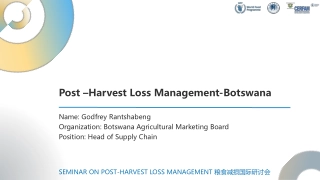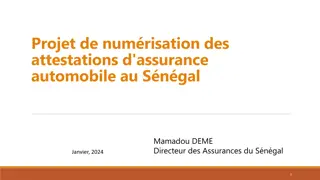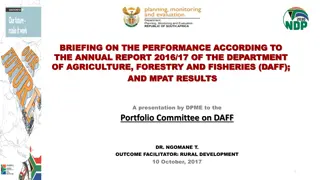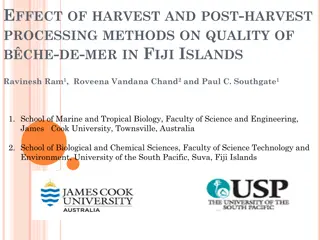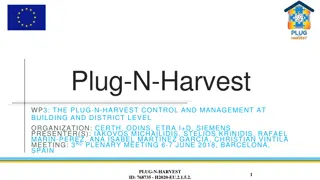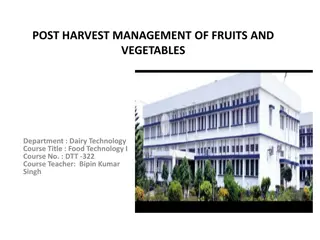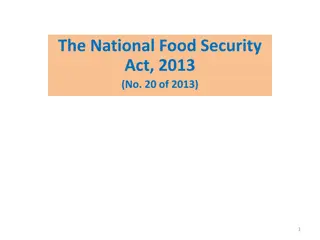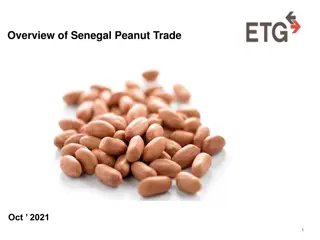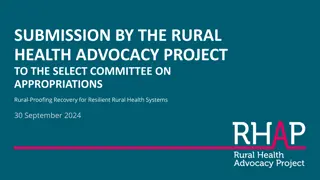Impact of Post-Harvest Equipment in Senegal on Rural Food Security
The paper explores the impact of post-harvest equipment provided through the Emergency Community Development Program (PUDC) on food security in rural households in Senegal. It addresses the challenges of hunger and food insecurity, reviews the methodology, and discusses how PUDC aims to improve food security by enhancing agricultural productivity. The study investigates if PUDC's interventions have enabled rural households to enhance their food security, focusing on access to infrastructure and basic services for economic development.
Download Presentation

Please find below an Image/Link to download the presentation.
The content on the website is provided AS IS for your information and personal use only. It may not be sold, licensed, or shared on other websites without obtaining consent from the author.If you encounter any issues during the download, it is possible that the publisher has removed the file from their server.
You are allowed to download the files provided on this website for personal or commercial use, subject to the condition that they are used lawfully. All files are the property of their respective owners.
The content on the website is provided AS IS for your information and personal use only. It may not be sold, licensed, or shared on other websites without obtaining consent from the author.
E N D
Presentation Transcript
Impact of the post-harvest equipment of the Emergency Community Development Program (PUDC) on the food security of rural households in Senegal 1 ND YE ADA KANE SOUS LA DIRECTION DU PR. SAMBA MBAYE
Outline Introduction Review Methodology Results and discussion ND YE ADA KANE SOUS LA DIRECTION DU PR. SAMBA MBAYE Conclusion 2
Introduction eliminating hunger and food insecurity has always been a central part of the international community's commitments, Millennium Development Goals (MDGs, 2000-2015); Sustainable Development Goals (SDGs, 2015-2030); 720 to 811 million people around the world are facing hunger and 12% of the world's population is food insecure (UN, 2021). In Africa, more than a third of people are undernourished (282 million in 2020) and hunger affects 21% of the population, numerous challenges such as population growth, conflicts, instability, climate change and most recently the covid-19 pandemic 3 ND YE ADA KANE SOUS LA DIRECTION DU PR. SAMBA MBAYE
Introduction food insecure households are estimated at 16% according to the Global Analysis of Vulnerability, Food Security and Nutrition (AGVSAN) in 2014 Many strategies have been put in place by the State of Senegal within the framework of the PES to achieve international goals in terms of food security Among these strategies is the Emergency Community Development Program (PUDC), which aims to strengthen short-term access to infrastructure and basic services for rural economic development. the PUDC has provided, since 2016, the rural world with post-harvest equipment in order to boost the agricultural sector by improving productivity and agricultural production. 4 ND YE ADA KANE SOUS LA DIRECTION DU PR. SAMBA MBAYE
Introduction Research Issue: Have PUDC's post-harvest equipments enabled rural households to improve their food security? The main objective of this paper is to assess the impact of PUDC's post-harvest facilities on household food security in Senegal. 5 ND YE ADA KANE SOUS LA DIRECTION DU PR. SAMBA MBAYE
Review of litterature In 1996, during the World Food Summit, food security was defined as follows: "food security is achieved when all people, at all times, have economic, social, and physical access to sufficient, safe, and nutritious food that meets their dietary needs and food preferences for an active and healthy life. Most authors agree on the multidimensional nature of food security and the many difficulties associated with its measurement (Maxwel et al. 2013; Sisha, 2019; Amaza et al. 2009; Cabral, 2010; Asige, 2022) It was difficult in this research to find previous studies on post-harvest equipment and food security. 6 ND YE ADA KANE SOUS LA DIRECTION DU PR. SAMBA MBAYE
Review of litterature However, considering post-harvest equipment as an integral part of post-harvest technology Much research has established that improved post-harvest technology can reduce wastage due to poor handling and thus could improve food availability, accessibility and utilization (Kabahenda, Omony, & H sken, 2009) and (Bank, 2018). In addition, many studies have been conducted on the determinants of food security: Cabral (2010), Kohai et al. (2005) , Goni (2005) , Amaza et al. (2009), Ad tomia et al.(2020) and Sisha (2019) income and/or consumption (represented by self-consumption), livestock income, net transfers, demographics such as household size and regional disparities, education,, access to credit, assets, household size, dependency ratio and shocks are variables that can affect food security 7 ND YE ADA KANE SOUS LA DIRECTION DU PR. SAMBA MBAYE
Review of litterature Regarding the impact of agricultural projects and programs on food security Asige (2022) ; Amaza et al (2009); (Adetomiwa, Mayowa, Adebayo, & Victor, 2020) (Akuffo & Quagrainie, 2019) evaluated agricultural projects and found significant impacts on food security we did not find any specific studies of the impact of post-harvest equipment on household food security. This makes our research interesting 8 ND YE ADA KANE SOUS LA DIRECTION DU PR. SAMBA MBAYE
Methodology Study area: In the context of this study, the groundnut basin area represents more than 85%. The remainder is in the river valley area, with approximately 13% of the households surveyed The sample is composed of 1124 households made up of 389 target households and 735 control households. Source: Center for Research on Economic and Social Development (CRDES) on the PUDC in 2016 and 2020. 9 ND YE ADA KANE SOUS LA DIRECTION DU PR. S AMBA MBAYE
Methodology Given the multidimensional nature of food security, several outcome variables were studied, mainly relating to the access and utilization dimensions of food security. the first outcome variable is the household dietary diversity score (HDDS): HDDS (0-12) = A+B+C+D+E+F+G+H+I+J+K+L The second study variable is the caloric consumption per Adult Equivalent Unit (AEU). The last three outcome variables are dichotomous variables related to the hunger gap and resilience strategies in the face of food insecurity. These are : the hunger season variable, which takes 1 if the household experienced a lean season during the year and 0 otherwise; 10 ND YE ADA KANE SOUS LA DIRECTION DU PR. SAMBA MBAYE
Methodology the strategy variable, which takes 1 if the household sold one or more of its assets to cope with the hunger gap and 0 otherwise; and the skip variable, which takes 1 if the household skipped meals during the hunger gap and 0 otherwise. The explanatory variables considered in this study are age, sex, marital status and the level of education of the head of the household. In addition, household variables such as household size, dependency ratio, access to credit, access to land, number of assets owned by the household, and income and expenditure variables are included in the model. 11 ND YE ADA KANE SOUS LA DIRECTION DU PR. SAMBA MBAYE
Methodology For continuous outcome variables such as hdds and caloric consumption the so-called double difference method is applied through a multiple regression model Y= 0 + 1*[Time] + 2*[Program] + 3*[Program*Time] + 4*[Control variables] + Here Program is a binary variable that takes the value 1 when the individual (or household more specifically in our thesis) benefits from the program and 0 otherwise. Time is a binary variable for the periods before and after the treatment. The term "program *time" refers to the impact of the program on the target group or program beneficiary. Control variables or covariates are those variables that can explain our outcome variable other than the program. 12 ND YE ADA KANE SOUS LA DIRECTION DU PR. SAMBA MBAYE
Methodology For dichotomous variables such as the hunger gap, strategy and meal skipping, we evaluated the effects of post-harvest equipment using a binary logistic regression of the type: ?? ??? = ? + ???? + ?? 1 ?? Where pi is the probability that the household is classified as food insecure and xit is a column vector of variables that vary both across households and over time for each household. 13 ND YE ADA KANE SOUS LA DIRECTION DU PR. SAMBA MBAYE
methodology Reason 2 databases available: 2016 and 2020 Criteria for selecting villages treated in PUDC not clearly defined DD can be applied to randomized or non-randomized programs It can be combined with other methods 14 ND YE ADA KANE SOUS LA DIRECTION DU PR. SAMBA MBAYE
Results and discussion/PUDC post-harvest equipment 66 pieces of post-harvest equipment have been granted under the program. 42 beneficiary villages Table 1 : Descriptive statistics for continuous variables in 2016 mean treated 5.1 3088.8 51.9 12.9 108.4 24.0 21026.7 22202.1 16909.1 21348.3 20401.2 8130.0 173.3 112.1 16255.0 15532.4 2571.4 48443.9 50297.2 21194.0 median treated 5.0 3174.5 52.0 11.0 100.0 21.0 16666.7 16800.3 21913.8 9062.5 8624.6 0.0 0.0 5291.7 3670.0 18714.2 19294.3 71591.0 sd Variables untreated 4.9 2898.5 52.7 12.9 109.5 25.5 23371.6 19458.8 51.2 14813.6 52141.0 total 5.0 2993.4 52.3 12.9 108.9 24.8 untreated 5.0 2967.2 53.0 11.0 100.0 22.0 total 5.0 3089.3 53.0 11.0 100.0 22.0 untreated 1.7 827.2 14.5 6.7 60.3 13.8 treated 1.6 834.1 13.9 6.4 61.2 12.7 16493.7 19423.9 35390.3 32578.6 2237.2 28458.2 29811.3 63177.5 67508.2 total 1.6 835.6 14.2 6.6 60.7 13.3 Household Dietary Diversity Score (HDDS) caloric consumption per adult equivalent unit age household size household dependency ratio number of assets in the household per capita food expenditure per capita non-food expenditure per capita income from processed products per capita agricultural income non-farm income per capita 29532.5 708.2 31119.1 0.0 1657.6 15 ND YE ADA KANE SOUS LA DIRECTION DU PR. SAMBA MBAYE
Results and discussion/ Analysis of descriptive Statistics Table 6 : Average evolution of indicators between 2016 and 2020 median unreated treated total 6.0 6.0 6.0 2922.2 3012.3 2962.0 55.0 56.0 55.0 12.0 12.0 12.0 100.0 90.0 93.7 14.0 16.0 15.0 28643.3 27498.3 18333.3 18823.5 18708.3 25104.0 13359.9 12708.1 5000.0 6250.0 354.6 364.3 0.0 0.0 21199.5 19646.2 4210.5 6857.1 36672.0 36118.4 18240.9 16799.2 17928.6 48085.5 Table 2 : Descriptive statistics for continuous variables in 2020 mean treated 6.4 3299.9 55.2 13.8 99.4 19.7 sd Variables untreated 6.0 3162.5 55.6 13.3 101.7 16.6 26359.0 12059.7 373.8 18100.8 35567.6 total 6.2 3231.0 55.4 13.6 100.6 18.2 untreated 1.5 1304.9 13.8 6.5 57.3 9.7 treated 1.9 1586.8 13.2 7.0 54.5 12.5 31122.9 28271.4 21825.4 22098.4 4212.9 46328.3 39383.0 63679.7 56370.5 total 1.7 1453.1 13.5 6.7 55.9 11.3 Household Dietary Diversity Score (HDDS) caloric consumption per adult equivalent unit age household size household dependency ratio number of assets in the household per capita food expenditure per capita non-food expenditure per capita income from processed products per capita agricultural income non-farm income per capita 5477.3 0.0 5083.9 22375.8 2946.7 30950.9 3631.4 16 ND YE ADA KANE SOUS LA DIRECTION DU PR. SAMBA MBAYE
Results and discussion/ Analysis of descriptive Statistics Table 3 : Average evolution of indicators between 2016 and 2020 mean Variables untreated treated total Household Dietary Diversity Score (HDDS) 21,60% 26,80% 24,20% caloric consumption per adult equivalent unit 9,10% 6,80% 7,90% age 5,40% 6,30% 5,90% household size 3,50% 6,60% 5,00% household dependency ratio -7,10% -8,20% -7,70% number of assets in the household -34,70% -17,80% -26,50% per capita food expenditure 12,80% 36,20% 23,90% per capita non-food expenditure -38,00% -37,40% -37,70% per capita income from processed products 629,50% 104,70% 225,00% per capita agricultural income 22,20% 30,40% 26,50% non-farm income per capita -31,80% -24,30% -28,20% 17 ND YE ADA KANE SOUS LA DIRECTION DU PR. SAMBA MBAYE
Results and discussion/ Analysis of descriptive Statistics Table 4: Calorie consumption per EA/day in target and control households Variables Control 2020variation 3162,5 77% 5% 18% 32% 21% 47% Target 2020variation 3299,9 74% 6% 20% 32% 17% 51% Total 2016 2898,5 76% 2016 3088,8 76% 2016 2020variation 2993,4 3231 75% 76% 7% 5% 18% 19% 26% 32% 21% 19% 52% 48% Average consumption Kcal/EA/day share of cereals commodities share of animal products share of condiments % At-risk households (<2400 Kcal/EA/day) % Moderately satisfied households (2400 - 3000 kcal) % Satisfied households (> 3000 kcal/EA/day) 9,10% 6,80% -2% 7,90% 1% -1% 0% 3% -1% -2% 1% -2% 1% 6% -2% -4% 6% 18% 29% 22% 49% 6% 18% 23% 21% 56% 0% 2% 9% -4% -5% On average, caloric consumption increased by 7.9% across the study population between 2016 and 2020. Target households show a 6.8% smaller increase than control households (+9.1%). basic products, consisting essentially of cereals, account for the largest share of the diet of rural households (over 74%), followed by condiments. The share of animal products is very low, below 10%. the percentage of vulnerable and at-risk households is still high (over 25%) and has even increased over the period 18 ND YE ADA KANE SOUS LA DIRECTION DU PR. SAMBA MBAYE
Results and discussion/ Results of the assessments Table 5: Equilibrium tests of the variables Variable(s) Household Dietary Diversity Score Household size sexe age ecole married single widowed credit per capita food expenditure per capita non-food expenditure household dependency ratio per capita income from processed products per capita agricultural income non-farm income per capita land number of assets in the household Mean Control 4.934 12.880 1.036 52.491 0.097 0.957 0.003 0.031 0.506 2.2e+04 1.9e+04 109.155 178.186 1.5e+04 5.0e+04 0.923 25.501 Mean Treated 5.062 12.938 1.026 52.149 0.126 0.964 0.008 0.026 0.427 2.2e+04 2.1e+04 108.735 45.660 1.6e+04 5.1e+04 0.915 24.003 Diff. 0.128 0.059 -0.010 -0.342 0.029 0.007 0.005 -0.005 -0.080 -103.698 2052.314 -0.420 -132.525 326.077 1336.871 -0.008 -1.499 |t| 1.11 0.12 0.82 0.34 1.28 0.53 1.01 0.42 2.23 0.07 0.88 0.10 1.12 0.15 0.28 0.41 1.58 Pr(|T|>|t|) 0.2684 0.9009 0.4146 0.7365 0.2024 0.5929 0.3148 0.6746 0.0258** 0.9406 0.3797 0.9231 0.2635 0.8787 0.7823 0.6783 0.1144 on all variables except the credit variable, there are no significant differences. These results confirm the fact that, overall, control and target households had the same characteristics at the beginning of the program 19 ND YE ADA KANE SOUS LA DIRECTION DU PR. SAMBA MBAYE
Results and discussion/ Results of the assessments Table 5: Estimation results for hdds using the double difference method VARIABLES time treatment impact Household size sexe age ecole Married single widowed credit per capita food expenditure per capita non-food expenditure household dependency ratio per capita income from processed products per capita agricultural income non-farm income per capita land number of assets in the household Constant Effets fixes Observations R-squared hdds 1.066*** (0.119) 0.128 (0.119) 0.291* (0.168) hdds 1.066*** (0.113) 0.128 (0.116) 0.291* (0.167) Hdds 0.775*** (0.178) 0.114 (0.116) 0.342** (0.169) -0.00113 (0.00793) 0.146 (0.311) 0.00888*** (0.00325) 0.208 (0.128) 0.385 (0.687) -0.0884 (0.833) 0.382 (0.747) -0.174** (0.0823) 3.06e-06 (2.12e-06) 4.73e-07 (2.01e-06) -0.000633 (0.000716) 4.56e-06 (8.37e-06) -5.09e-07 (1.31e-06) -3.82e-07 (6.82e-07) -0.136 (0.134) 0.00137 (0.00355) 4.127*** (0.844) oui 2248 0.137 4.934*** (0.0840) 4.934*** (0.0836) oui 2248 0.124 2248 0.124 20 ND YE ADA KANE SOUS LA DIRECTION DU PR. SAMBA MBAYE
Results and discussion/ Results of the assessments Chart 3 : marginal effects of treatment on HDDS Chart 3 shows the marginal effects of the program over time. Indeed, between 2016 and 2020, hdds increases among both beneficiary and control households, but the increase is much larger among beneficiary households thanks to the program. Intervention's Impact: treatment/control comparison 6.5 Linear Prediction 6 5.5 5 baseline endline round traitement=0 traitement=asobserved traitement=1 The regression results show that the program had a negative but not significant impact on caloric intake. In addition, none of the covariates except for the number of assets variable had a significant impact on caloric consumption. 21 ND YE ADA KANE SOUS LA DIRECTION DU PR. SAMBA MBAYE
Results and discussion/ Results of the assessments Table 12 : the effects of the treatment on the existence or not of a hunger gap Hunger gap Coef. Std. Err. z P>|z| [95% Conf. Interval] average treatment effect on treated -.0440026 .022141 -1.99 0.047 -.087398 -.0006071 Pomean traitement .7660103 .0152112 50.36 0.000 .7361969 .7958237 the estimates of the program's effects using a logit regression model reveal that the granting of post-harvest equipment to households had a negative effect on the hunger gap for beneficiary households, on the sale of goods as a means of escaping food insecurity, and on meal skipping during the hunger gap. Indeed, Table 9 shows that the effect on the hunger gap is negative and significant at the 5% level. In other words, providing the rural world with these types of machines has allowed them to experience fewer lean times. Consequently, this positively affects their food security because the lean season is a difficult period for rural households during which they are forced to adopt resilience strategies such as selling their goods or skipping meals to cope with food insecurity. 22 ND YE ADA KANE SOUS LA DIRECTION DU PR. SAMBA MBAYE
Conclusion The results of the double-difference method showed that post-harvest equipment had a positive and significant impact on hdds. However, for caloric consumption, the regression shows a negative coefficient but it is not significant. In addition, the results of the regression by the binary logistic model showed that post-harvest equipment reduced households' experience of the hunger gap, the sale of goods to cope with the hunger gap, and meal skipping. This translates into a positive impact on food security. 23 ND YE ADA KANE SOUS LA DIRECTION DU PR. SAMBA MBAYE
Conclusion For a better impact on food security, we recommend that decision-makers : To provide the rural world with post-harvest equipment that meets modern standards and that corresponds to the needs of villagers in terms of quantity, as the qualitative survey conducted as part of this study revealed these shortcomings; Expand the range of post-harvest equipment, since most of the machines granted are hullers and mills. The aim is to follow the entire value chain of the agricultural product from harvesting to processing and marketing by providing the rural world with more conservation and storage infrastructure, but also with equipment to improve processing; To invest more in human capital by strengthening the capacities of agricultural producers on new technologies in agriculture and rainfall information in order to cope with climate change. 24 ND YE ADA KANE SOUS LA DIRECTION DU PR. SAMBA MBAYE
Thank you for your interest 25 ND YE ADA KANE SOUS LA DIRECTION DU PR. SAMBA MBAYE



